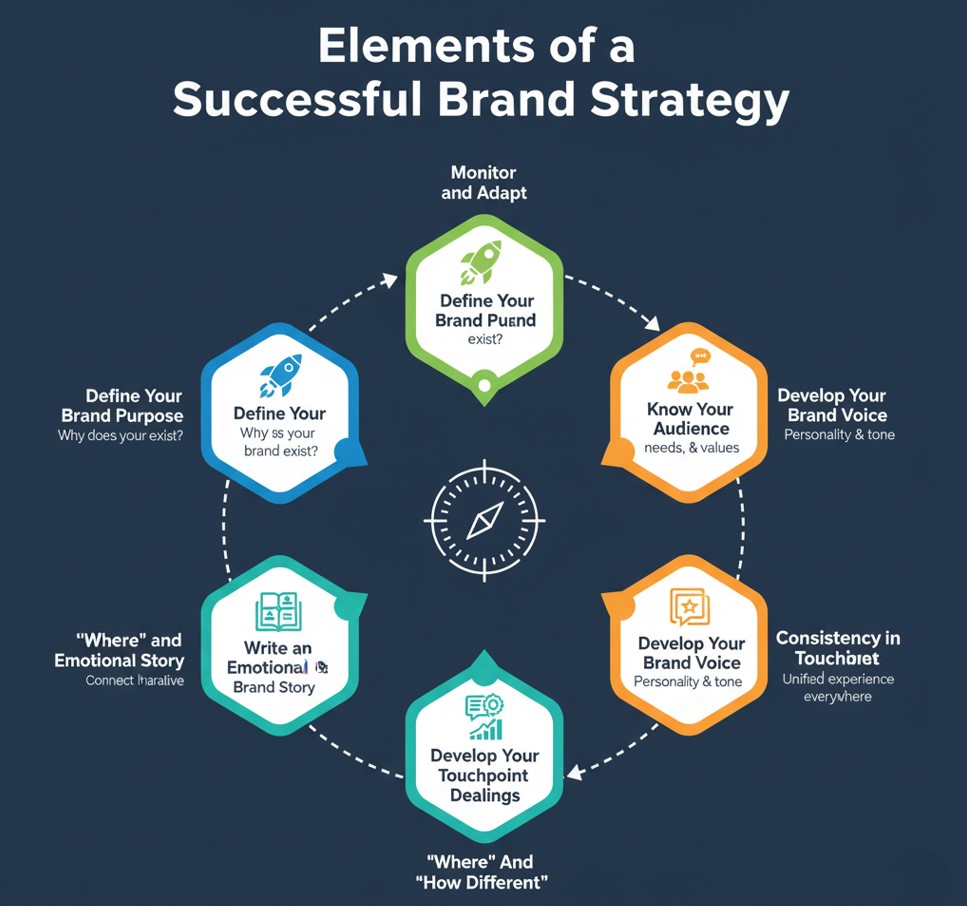If you want to differentiate a business, get closer to customers, and earn lifelong relationships with them, there’s only one word to comes to your mind – it’s branding strategy. But what does it really mean? And most importantly, what are you branding strategies can you use effectively to succeed with your business?
In this article, you’ll learn the basics of a branding strategy in marketing and why it is important to marketing, along with how to create a strategic branding approach that will connect your audience and last for years to come.
What is Branding in Marketing Strategy?
A Branding Strategy is a long-term strategy for building a successful, recognisable, and influential brand. It includes all facets of a business’s branding: logos, colors, how customers are treated, and the words a company uses to describe itself. More than logos or tight taglines, a branding strategy delves into the personality, mission, and promises a business makes to its customers.
How It Works for Them
A befitting brand strategy is what helps companies to:
- Their message and values are clear to them.
- Unified communication experience and customer communication across all channels.
- A relationship that develops trust and loyalty with the audience.
At its heart, branding strategy ensures that every aspect of your brand tells a consistent and compelling story that your customers don’t just remember—they connect with.
Why Branding Strategy Matters
The role of branding strategy cannot be overstated. Consider some of the most well-recognized companies in the world, such as Apple, Nike, or Coca-Cola. What is true of all those? Their brand continues to articulate their distinctive identity, value, and promise to customers.
And the reasons for hype over branding strategy aren’t dissimilar.
Standing Out in a Crowded Marketplace
With millions of competitors out there, you need to stay ahead. Your brand strategy explains your business to the world: why you’re different, what you stand for, and why your customers should choose you over the other guys.
Take TOMS for example — that’s not just a shoe company. It’s a brand with a mission. Its “One for One” model, which sees a proportion of each sale go to a specific cause, is a good example of differentiation through brand.
Creating Emotional Bonds
Good branding isn’t only about products; it’s the experience your customers have with your products and the feelings they associate with your business. Trust, loyalty, and emotional connection bring customers back.
For example, branding at Patagonia is driven by sustainability and environmental activism. Consumers who appreciate these principles naturally connect with the brand.
Driving Customer Loyalty
When consumers can recognize and connect with a brand, they’re not simply purchasing items; they’re becoming a part of that brand’s story. This level of involvement turns indifferent purchasers into advocates of your business.
Enhancing Marketing ROI
Effective branding is a great way to make all your marketing efforts more successful. When your customers already know and love your brand, you get extra engagement out of your campaigns and more bang for your buck from your marketing budget.
Elements of a Successful Brand Strategy
Identifying the elements of branding tactics can help it feel more manageable. Here is what a successful branding strategy includes:
Define Your Brand Purpose
Why does your brand exist? What does your company exist to do, beyond making money? You can use a clear purpose to inform everything from your messaging to how you make products and services.
For example, Tesla’s mission is to accelerate the world’s transition to sustainable energy, and this mission permeates every facet of the company.
Know Your Audience
Your brand should reflect the wants, needs, and values of your customers to whom you are serving. Develop in-depth buyer personas to get a feel for what matters to them, what they’re struggling with, and how they prefer to get information.
If your audience appreciates eco-friendly products, for instance, ensure that your branding highlights a commitment to sustainability — in design, in messaging, in partnerships, etc.
Develop Your Own Brand Voice
Does your brand represent fun and offbeat, high-end or exclusive, or friendly and approachable? Creating a persona helps to humanize your brand and makes it relatable to people. Leverage this personality for the tone of your messaging, the tone of your brand online, and customer interactions.
Consistency in Touchpoint Dealings
Like your logo, your colors, but also website design, social media handles, I mean, even your employees when they answer the phone should all be unified under a consistent, seamless branding strategy. It helps consumers to see your brand and trust it, regardless of where they see it.
Write an Emotional Brand Story
The power of storytelling in brand building is immense. Tell your story of where you come from, what obstacles you face, and what it is you are out to accomplish viscerally. No one wants to do business with people; we all want to do business with people.
“Where” and “How Different”
What is your brand’s place in the market? Is it because you are a premium luxury brand, but your products are inferior by cost? Where you position your brand is crucial in terms of how customers compare your brand with others.
Monitor and Adapt
Just as with markets or customer expectations, branding can’t stand still. Through consistently gathering feedback and tracking performance metrics, you can adjust your brand strategy so that it remains effective and relevant.
Remarks on Great Branding
There are two parts of a great branding campaign: the first is a solid brand strategy, and the second is great creative work.
Nike
Nike’s branding reaches far beyond its “Just Do It” slogan. It suggested an attitude of tenacity, self-fulfillment and athleticism to its viewers. The brand’s storytelling in campaigns like “Dream Crazy” with Colin Kaepernick hits on an emotional level and continues to underscore its mission to empower athletes.
Apple
Minimalism, innovation, and user-centered design are the hallmarks of Apple’s branding. Nowhere is the brand’s pursuit of simplicity and perfection more evident than at every product launch, ad campaign and retail store.
Airbnb
Airbnb is all about belonging. Its “Belong Anywhere” campaign reflects the inclusive, global community it seeks to create, speaking directly to a desire, among its audience, for real travel experiences.
What You Need to Know About Branding Strategy
If you’re launching a new brand or revitalizing an old one, here are a few steps to help you get started with your branding strategy:
- Evaluate where your brand is failing and make the necessary changes.
- Study your audience and competition to figure out what openings exist.
- Determine the purpose, mission, and values of your brand.
- Create your visual identity (logo, color scheme, typography.)
- Develop a guide for your style of communication so you can use the same message.
- Roll out your brand strategy and track how well your plans are being met through things like customer engagement, rates of loyalty, and growth in market share.
Make Your Brand Unforgettable
The first ensures a successful and enduring growth, customer loyalty and market distinction. It’s not so much what you sell, but what you represent and how you make your customers feel.
Creating an outstanding branding strategy can be a daunting task, but it’s a gamble worth taking. Begin telling your story now and establish your brand as a remarkable figure in your market.
Learn more about: How to Increase Brand Awareness Through Digital Marketing










